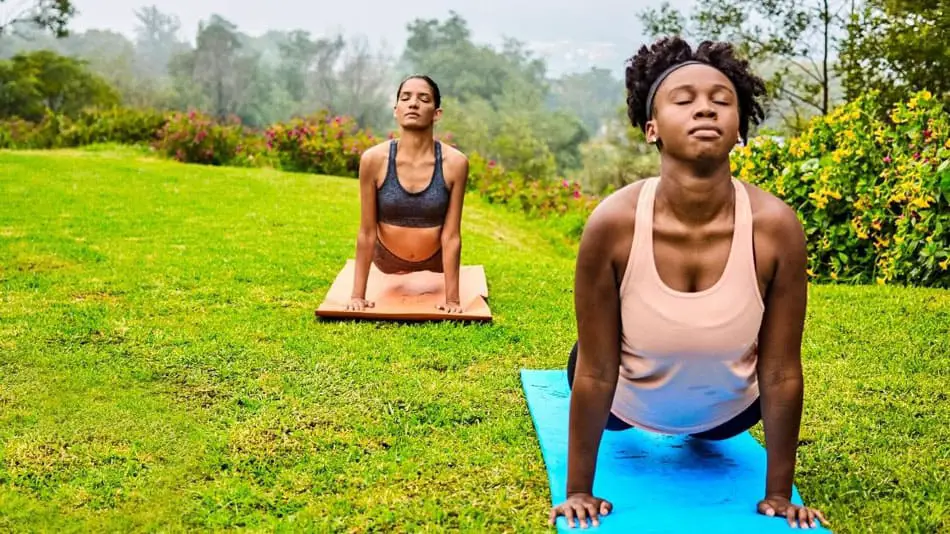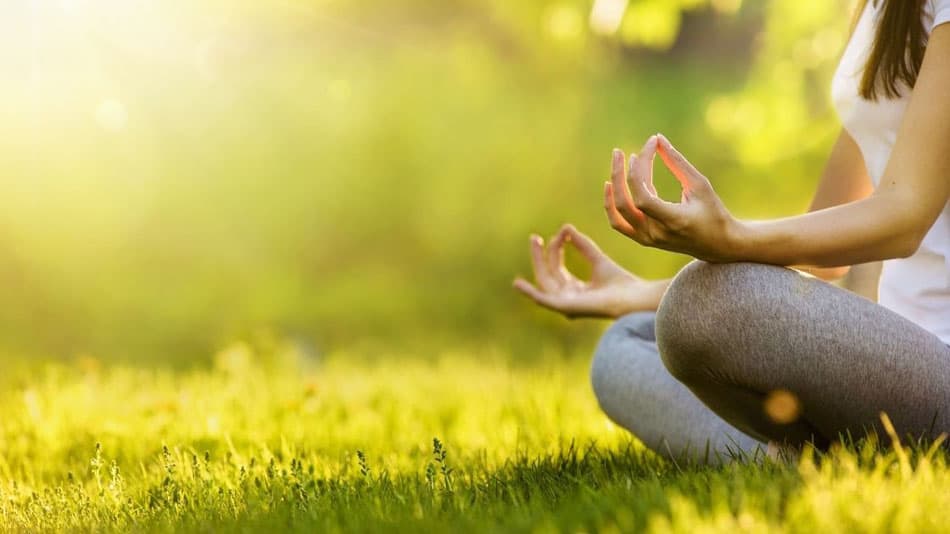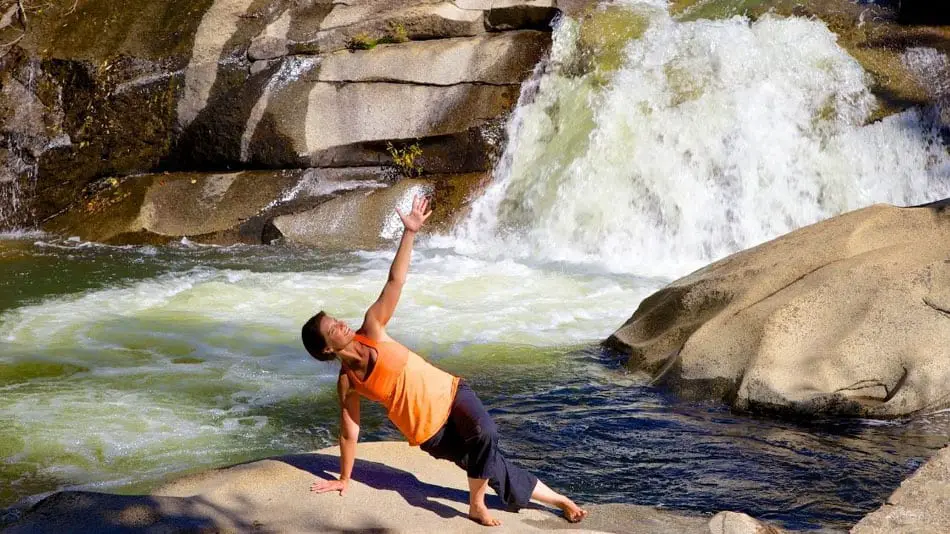
Yoga is the perfect go-to for trail runners as it offers everything you need to prepare for and soothe your body after a long run in the great outdoors.
Both yoga and trail running offer us a way to stay present, care for our bodies, and connect with the world around us – bring the two together, and you’ve got the ultimate self-care routine!
What makes yoga the perfect partner for trail running is that it helps us improve our focus, strengthen our bodies, and maintain mobility – 3 things that are crucial to our running performance.
In this post, we’ll discuss the benefits of combining trail running with yoga, what you need to know before getting started with your yoga practice, the best time to practice, as well as 7 of the best mobility yoga poses for trail runners.
The best mobility yoga poses for trail runners.
- Downward Facing Dog
- Lizard Pose
- Pyramid Pose
- Seated Forward Fold
- Tree Pose
- Figure 4 Pose
- Legs ups The Wall
Read on to find out more about these poses and how to practice them.
What are the benefits of combining trail running with yoga?
Though yoga has endless benefits, here are some of the most crucial for trail running.
- Yoga improves balance and strength.
Balance and strength are vital elements of your performance during trail running.
- Increases breath control
Yoga is all about the breath – we time our positions with the breath, we move with the breath, and we try always to remain present to our breath. Working on breath control will improve your stamina during trail running.
- Extends range of motion
Practicing yoga improves mobility and extends your range of motion – making it less likely for you to get injured while trail running.
- Improves focus
An improved focus and awareness of your surroundings make it easier to run on uneven and tricky surfaces.

What do you need to know before you get started?
Here are a few things to bear in mind so that you can make the most of your yoga practice in relation to running.
- Pranayama
Begin your practice with a short pranayama (or controlled breathing) to help you quiet the mind and start to focus. Here’s an easy pranayama practice to get you started:
- Sit comfortably and close your eyes.
- Root through the sit bones as you grow tall through the crown of the head.
- Start to breathe in and out through your nose. Pay attention to how your breath feels as it enters and leaves your body.
- Inhale to the count of 7.
- Hold for the count of 4.
- Exhale for the count of 7.
- Hold for the count of 4.
- Repeat for 3-5 minutes.
- Be aware of your body.
Remain aware and in touch with your body throughout your practice. If something feels painful, don’t do it! Always listen to what your body is telling you and back off when needed.
Similarly, if your body invites you deeper into the poses, feel free to experiment with this too! Just remain aware of healthy and correct alignment.
- Pre or post-run?
Using yoga as a warm-up is a great way to prepare for a trail run and loosen any stiff muscles and joints before you head off.
Flow-through some of the poses mentioned below, holding them for no more than 3-5 breaths each.
Yoga is also one of the best ways to help your body recover after trail running. Practicing deep stretches will soothe your muscles, your nervous system, prevent injury, and speed up your recovery time.
When practicing yoga after trail running, hold poses for 2-3 minutes to release tension in the muscles.
7 of the best mobility yoga poses for trail runners
Downward Facing Dog
Downward-facing dog is an effective pose for strengthening the shoulders and opening the upper back – a great tool to keep the upper body engaged but relaxed while trail running.
Start from all fours, then bring your hands just one palm print in front of your shoulders. Take an inhale, curl the toes, and on an exhale, push into the hands and feet to lift your hips to the sky.
It’s essential to keep your spine straight, so bend your knees as much as you need to allow you to do this. Push into the heel of your hand and all five fingertips, and let the headrest between the biceps.
Imagine that you’re trying to hide your armpits to create space between the shoulder blades
Lizard Pose
Lizard pose is fantastic for stretching the psoas muscle and quads.
Come into a plank position with your knees resting on the floor and the wrists directly underneath the shoulders. Then step your right foot to the outside edge of your right hand, letting the hips get heavy as they sink towards the mat – you should feel a wonderful stretch here!
Come down to the forearms to deepen the stretch, or bring blocks under the hands to make it less intense.
Repeat on the other side.

Pyramid Pose
Pyramid pose creates a deep stretch in the hamstrings that can help you to prepare and recover from trail running.
Stand on your mat with your feet hip-distance apart. Take one step forward with your right foot, then turn your left toes out to around 45 degrees. Take an inhale, and as you exhale, hinge at the hips, bringing the chest to parallel with the ground.
You can bring your hands to the floor or blocks, and as long as you have no back pain or a stretching sensation behind the knee, you can bring the torso closer to the front leg.
Repeat on the other side.
Seated Forward Fold
Seated forward fold is another excellent hamstring stretch and probably best practiced after trail running.
Start by sitting on your mat with your legs straight out in front of you, and your toes pointed towards the ceiling. Take a breath in, then exhale to hinge at the hips and bring the belly and the chest towards your legs. Only go as far as you can while keeping your back straight – if you have no pain in the back, you can gently round the spine and drop the head.
If you find it challenging to sit up straight with your legs in front of you, bring a cushion or folded blanket underneath the sit bones.
If the stretch feels too intense, keep a slight bend in the knees.
It can be nice to create a tower between your knees – using yoga blocks – as a place for you to rest your forehead.
Tree Pose
Tree pose is one of the first balancing poses that people learn in yoga and a wonderful one to practice regularly. It will improve your focus while opening the hips and strengthening the ankles – the perfect pose for trail runners!
Start by standing on your mat with your feet just slightly apart. Bring all of your weight into your right foot as you bring the sole of the left foot to rest on your calf or inner thigh. Bring the hands to your heart in a prayer position and lift them above your head for greater focus.
Stretch the inner hip by opening the knee out – as though you’re trying to bring it behind you.
If you have any pain in the standing leg’s knee, bring the toes of the lifted leg to the ground, with the sole resting gently on the ankle.
Repeat on the other side.
Figure 4 Pose
Figure 4 pose is particularly soothing after a trail run – it feels wonderful on sore hips and will stretch the glutes.
Start by laying on your back on the mat with the knees bent and feet resting on the floor. Bring your right ankle to rest on your left knee. Stay here if it feels like enough of a stretch! If you would like a deeper stretch, bring the hands behind the left hamstring or shin – keeping your shoulders on the ground as you gently pull your knee towards you.
Repeat on the other side.
Legs up the Wall
Legs up the wall is a wonderfully restorative pose to rest in after a trail run and will help lower your heart rate and relax the legs.
Lay on your back with your glutes against a wall and your legs up the wall. Bring your hands to rest on either side of your body, close your eyes, and relax for 10-15 minutes.
To make this pose into an inversion, bring a couple of blocks or large pillows underneath the lower back.
The easiest way to get into this pose is by laying with one side of your body against the wall and then turning to bring your legs to reach up the wall.
The takeaway
Taking the time to care for your body before and after trail running can benefit your running practice – you’ll gain focus, mobility, better control of your breath, as well as potentially improving your time and experience.
Do you practice yoga alongside trail running? What’s your favorite pose for recovery?
